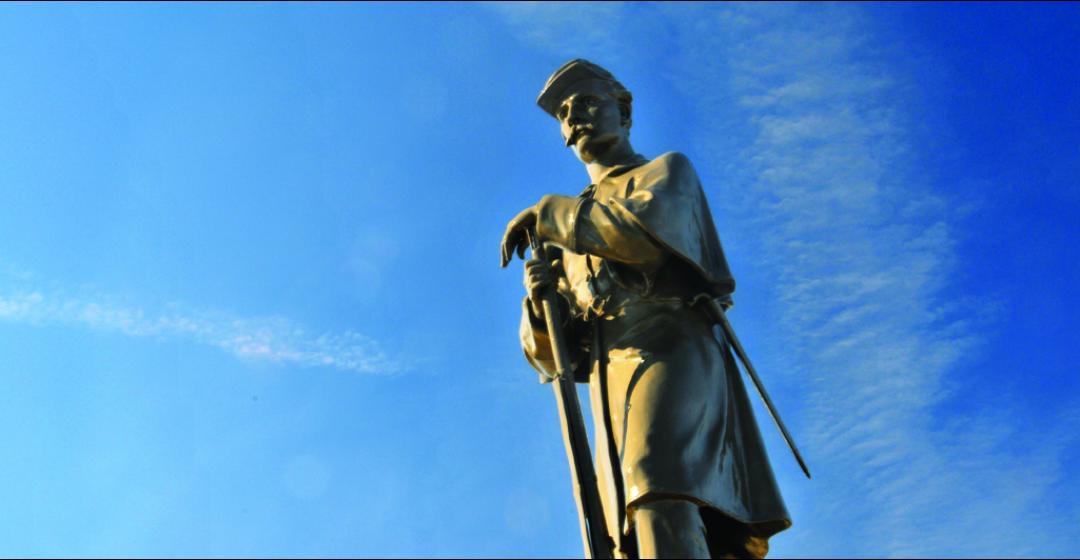Sometimes the arc of the moral universe is long and slow, and sometimes it curves sharply, making up for wasted time. That was the case last month as scattered calls to remove the Confederate battle flag from the South Carolina capitol ignited a nationwide call to expel Confederate symbols from all parks and government buildings. In the weeks following the massacre of black worshipers in a Charleston church, plans were laid to topple Confederate statues from Texas to Florida, with more surely to come. On the Vineyard, thoughts turned to our own so-called Confederate monument, a Civil War soldier that stands sentry near the Oak Bluffs Steamship Authority terminal. Rumormongers claimed the Rev. Al Sharpton would soon arrive to see to its undoing, his visit timed to align with President Obama’s.
But hold up; let’s press pause on the rumormongering for a moment. Despite often being described as a Confederate soldier, the statue is, in fact, of a Union serviceman, notes Tom Dunlop in an August 2013 issue of this magazine. Much of the confusion, he writes, can be traced to a poorly conceived paint job. Perhaps appropriate for a town with deep African American roots, the monument was conceived as a way to commemorate the nation’s reunification after a great divide.
The statue does not honor the once enslaved – other than by extension those who fought for the Union. But, as this adaptation from Dunlop’s story shows, the symbolic power of the sole memorial north of the Mason-Dixon Line to honor soldiers on both sides is only enhanced by the facts. -MVM
In its day, it was one of scores of statues exactly like it, selected from a foundry catalogue. The soldier, a Union infantryman, stands at parade rest, the initials “U.S.” inscribed on his belt buckle and cartridge sack. Originally the statue stood at the head of Circuit Avenue in Oak Bluffs, erected there in the summer of 1891 to honor the Grand Army of the Republic, a fraternal organization of Civil War veterans.
All plain enough. How then, over the succeeding decades and all across the Vineyard, did this statue come to be thought of as a Confederate soldier?
The story begins with Charles Strahan, born in Baltimore on November 10, 1840. A Southerner frustrated that his native state had remained in the Union, in 1862 he joined the Maryland Guards, a segment of the Confederate army that was later incorporated into the 21st Virginia Regiment. Strahan was twenty-five miles away from Appomattox Court House when Robert E. Lee surrendered in 1865, and he recalled with gratitude the mercy that General Grant had shown the defeated rebel army.
Strahan moved his family to the Vineyard in 1884 and took over the Cottage City Star, renaming it the Martha’s Vineyard Herald. Seven years later, he offered to erect a monument to the Grand Army of the Republic in his new hometown, paying for it with every dollar earned from new subscriptions that year....
The Soldiers’ Memorial Fountain, as it was formally known, was dedicated on August 13, 1891. “That this comes from one who once wore gray,” said Strahan, “I trust will add significance to the fact that we are once more a union of Americans, a union which endears with equal honor the citizen of Georgia with the citizen of Maine; that Massachusetts and South Carolina are again brothers; that there is no North nor South, no East nor West, but one undivided, indivisible Union.”
Inscriptions on three sides honored the Grand Army of the Republic as a whole and its Island chapter in particular. After the ceremony, Strahan wrote of his hope that the monument would at last dissipate the “mists of prejudice,” and that veterans of the Union Army might, in turn, offer a tribute to their old foes on the uninscribed side of the monument. It took several decades, but on September 4, 1925, the remaining members of the Vineyard post of the Grand Army of the Republic came through... “‘The chasm is closed,’” it read. “In memory of the restored Union this tablet is dedicated by Union veterans of the Civil War and patriotic citizens of Martha’s Vineyard in honor of the Confederate soldiers.”
In 1930 the statue and fountain were moved to their current location. Over time, the soldier lost his rifle, scabbard, and a hand, and decay began to eat away at the statue and pedestal. In 1974, while preparing for the American bicentennial, the Oak Bluffs Parks Commission decided to paint the statue gray to emphasize its tie to the former Confederate soldier. Instead, the paint change left behind the Island-wide impression that the statue was of Johnny Reb himself.





